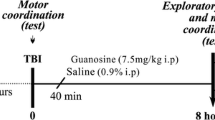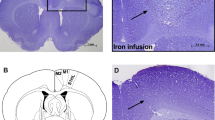Abstract
Spinal cord injury (SCI) leads to an alteration of energetic metabolism. As a consequence, glutamate, glutamine, aspartate and other important amino acids are altered after damage, leading to important disregulation of the neurochemical pathways. In the present study, we characterized the acute-phase changes in tissue concentration of amino acids involved in neurotransmitter and non-neurotransmitter actions after SCI by contusion in rats. Animals were submitted to either laminectomy or SCI by contusion and sacrificed at 2, 4, 8, and 12 h after lesion, for the analysis of tissue amino acids by HPLC. Results showed that both aspartate and glutamate contents diminished after SCI, while glutamine concentrations raised, however, the sum of molar concentrations of glutamate plus glutamine remained unchanged at all time points. GABA concentrations increased versus control group, while glycine remained unchanged. Finally, citrulline levels increased by effect of SCI, while taurine-increased only 4 h after lesion. Results indicate complex acute-phase changes in amino acids concentrations after SCI, reflecting the different damaging processes unchained after lesion.




Similar content being viewed by others
References
Tei R, Kaido T, Nakase H, et al (2005) Secondary spinal cord hypoperfusion of circumscribed areas after injury in rats. Neurol Res 27:403–408
Hausmann ON (2003) Post-traumatic inflammation following spinal cord injury. Spinal Cord 41:369–378
Bethea JR, Dietrich WD (2002) Targeting the host inflammatory response in traumatic spinal cord injury. Curr Opin Neurol 15:355–360
Diaz-Ruiz A, Rios C, Duarte I, et al (1999) Cyclosporin-A inhibits lipid peroxidation after spinal cord injury in rats. Neurosci Lett 266:61–64
Ekshyyan O, Aw TY (2004) Apoptosis in acute and chronic neurological disorders. Front Biosci 9:1567–1576
Park E, Velumian AA, Fehlings MG (2004) The role of excitotoxicity in secondary mechanisms of spinal cord injury: a review with an emphasis on the implications for white matter degeneration. J Neurotrauma 21:754–774
McAdoo DJ, Xu G, Robak G, et al (2000) Evidence that reversed glutamate uptake contributes significantly to glutamate release following experimental injury to the rat spinal cord. Brain Res 865:283–285
Kosenko E, Llansola M, Montoliu C, et al (2003) Glutamine synthetase activity and glutamine content in brain: modulation by NMDA receptors and nitric oxide. Neurochem Int 43:493–499
Danbolt NC (2001) Glutamate uptake. Prog Neurobiol 65:1–105
Agrawal SK, Fehlings MG (1997) Role of NMDA and non-NMDA ionotropic glutamate receptors in traumatic spinal cord axonal injury. J Neurosci 17:1055–1063
Schwartz-Bloom RD, Sah R (2001) γ-Aminobutyric acidA neurotransmission and cerebral ischemia. J Neurochem 77:353–371
Tillakaratne NJ, Mouria M, Ziv NB, et al (2000) Increased expression of glutamate decarboxylase (GAD(67)) in feline lumbar spinal cord after complete thoracic spinal cord transection. J Neurosci Res 60:219–230
Gundersen RY, Vaagenes P, Breivik T, et al (2005) Glycine–an important neurotransmitter and cytoprotective agent. Acta Anaesthesiol Scand 49:1108–1116
Eulenburg V, Armsen W, Betz H, et al (2005) Glycine transporters: essential regulators of neurotransmission. Trenes Biochem Sci 30:325–333
Parsons CG, Danysz W, Hesselink M, et al (1998) Modulation of NMDA receptors by glycine-introduction to some basic aspects and recent developments. Amino Acids 14:207–216
Simpson RK Jr, Robertson CS, Goodman JC (1996) The role of glycine in spinal shock. J Spinal Cord Med 19:215–224
Schaffer S, Takahashi K, Azuma J (2000). Role of osmoregulation in the actions of taurine. Amino Acids 19:527–546
Tappaz ML (2004) Taurine biosynthetic enzymes and taurine transporter: molecular identification and regulations. Neurochem Res 29:83–96
Foos TM, Wu JY (2002) The role of taurine in the central nervous system and the modulation of intracellular calcium homeostasis. Neurochem Res 27:21–26
Stover JF, Unterberg AW (2000) Increased cerebrospinal fluid glutamate and taurine concentrations are associated with traumatic brain edema formation in rats. Brain Res 875:51–55
Smullin DH, Skilling SR, Larson AA (1990) Interactions between substance P, calcitonin gene-related peptide, taurine and excitatory amino acids in the spinal cord. Pain 42:93–101
Heneka MT, Feinstein DL (2001) Expression and function of inducible nitric oxide synthase in neurons. J Neuroimmunol 114:8–18
Xu J, Kim GM, Chen S (2001) iNOS and nitrotyrosine expression after spinal cord injury. J Neurotrauma 18:523–532
Diaz-Ruiz A, Ibarra A, Perez-Severiano F, et al (2002) Constitutive and inducible nitric oxide synthase activities after spinal cord contusion in rats, Neurosci Lett 319:129–132
Watanabe M, Fujimura Y, Nakamura M, et al (1998) Changes of amino acid levels and aspartate distribution in the cervical spinal cord after traumatic spinal cord injury. J Neurotrauma 15:285–293
Panter SS, Yum SW, Faden AI (1990) Alteration in extracellular amino acids after traumatic spinal cord injury. Ann Neurol 27:96–99
Demediuk P, Daly MP, Faden AI (1989) Effect of impact trauma on neurotransmitter and nonneurotransmitter amino acids in rat spinal cord. J Neurochem 52:1529–1536
Basso DM, Beattie MS, Bresnahan JC (1996) Graded histological and locomotor outcomes after spinal cord contusion using the NYU weight-drop device versus transection. Exp Neurol 139:244–256
Perez-Neri I, Montes S, Boll MC, et al (2004) Liquid chromatographic-fluorimetric method for the estimation of nitric oxide biosynthesis in the central nervous system. J Chromatogr B Analyt Technol Biomed Life Sci 806:133–139
van der Hayden JA, Korf J (1978) Regional levels of GABA in the brain: semi-automated assay and prevention of post-morterm increase by 3-mercaptopropionic acid. J Neurochem 31:197–203
Perez-Neri, Castro E, Montes S, et al (2006) Arginine, Citrulline and nitrate concentration in the cerebrospinal fluid from acute hydrocephalus patients. J Chromatogr B (in press)
Mills CD, Xu GY, McAdoo DJ, et al (2001) Involvement of metabotropic glutamate receptors in excitatory amino acid and GABA release following spinal cord injury in rat. J Neurochem 79:835–848
Xu GY, Hughes MG, Ye Z (2004) Concentrations of glutamate released following spinal cord injury kill oligodendrocytes in the spinal cord. Exp Neurol 187:329–336
Patel AJ, Weir MD, Hunt A, et al (1985) Distribution of glutamine synthetase and glial fibrillary acidic protein and correlation of glutamine synthetase with glutamate decarboxylase in different regions of the rat central nervous system. Brain Res 331:1–9
Broer S, Brookes N (2001) Transfer of glutamine between astrocytes and neurons. J Neurochem 77:705–719
Laake JH, Slyngstad TA, Haug FM, et al (1995) Guamine from glial cells is essential for the maintenance of the nerve terminal pool of glutamate: immunogold evidence from hippocampal slice cultures. J Neurochem 65:871–881
Benton RL, Ross CD, Miller KE (2000) Glutamine synthetase activities in spinal white and gray matter 7 days following spinal cord injury in rats. Neurosci Lett 291:1–4
Profyris C, Cheema SS, Zang D, et al (2004) Degenerative and regenerative mechanisms governing spinal cord injury. Neurobiol Dis 15:415–436
Stys PK (1998) Anoxic and ischemic injury of myelinated axons in CNS white matter: from mechanistic concepts to therapeutics. J Cereb Blood Flow Metab 18:2–25
Ramonet D, Rodriguez MJ, Fredriksson K, et al (2004) In vivo neuroprotective adaptation of the glutamate/glutamine cycle to neuronal death. Hippocampus 14:586–594
Rodriguez MJ, Robledo P, Andrade C, et al (2005) In vivo co-ordinated interactions between inhibitory systems to control glutamate-mediated hippocampal excitability. J Neurochem 95:651–661
Louzada PR, Lima AC, Mendonca-Silva DL, et al (2004) Taurine prevents the neurotoxicity of beta-amyloid and glutamate receptor agonists: activation of GABA receptors and possible implications for Alzheimer’s disease and other neurological disorders. FASEB J 18:511–518
Acknowledgment
This work was supported by CONACyT grant No. 47467.
Author information
Authors and Affiliations
Corresponding author
Rights and permissions
About this article
Cite this article
Diaz-Ruiz, A., Salgado-Ceballos, H., Montes, S. et al. Acute Alterations of Glutamate, Glutamine, GABA, and Other Amino Acids After Spinal Cord Contusion in Rats. Neurochem Res 32, 57–63 (2007). https://doi.org/10.1007/s11064-006-9225-5
Received:
Accepted:
Published:
Issue Date:
DOI: https://doi.org/10.1007/s11064-006-9225-5




